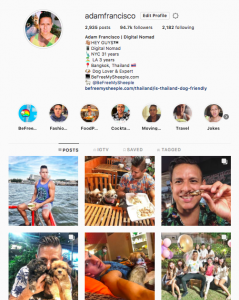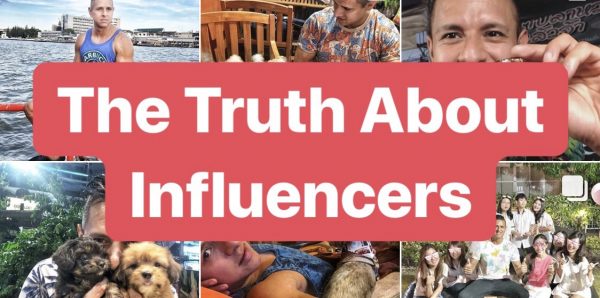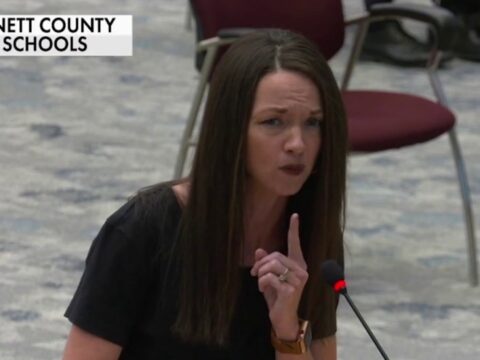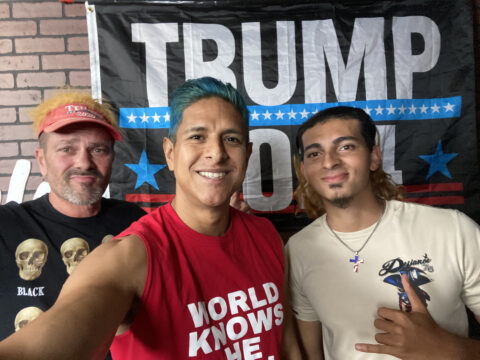Anybody can be an influencer, but not everybody can influence.
I had 100k+ followers
A lot of people congratulated me when I hit 100k followers on my Instagram. I gotta admit – it felt pretty good. But more importantly – it looked really good. People started to react differently to me when we’d exchange Instagram accounts. “Wow – you’re huge!” “OMG are you famous?” I started getting invited to exclusive events. I went on free trips. I was even making a livable income by posting branded content. Just recently got into a club in Bangkok (where I live) by showing management my Instagram account (I was wearing a tank top and there was a strict dress code). They thought I was an actor they just didn’t recognize.
Recently, my number of followers has fallen below 95k (from a peak of 101k) and a few people have noticed and asked me “what happened?”. Have I suddenly become less popular? Has my content become worse to the point that people are unfollowing me? Actually, the opposite has happened but you wouldn’t know that if you used my follower count as a measure of my “influence” (start paying attention advertisers).

Later in this article, I’ll show you how to determine who is an authentic influencer. If you’ve ever wondered “why is this person so popular?” you’ll be able to easily find out if they really are (and then not feel as bad that you’re not as popular).
Follower Count = Vanity Metric
The problem with Instagram is that the entire influencer ecosystem is mostly based on 1 single metric: follower count. The more followers you have, the more money you get paid by brands, the more free trips you go on & the more exclusive event access you get. The higher the follower count, the better it looks and the more money you make and the more you can travel.
I met a hilarious comedian in New York City a few months ago after seeing his show. We exchanged Instagrams and he was both amazed & jealous at how many followers I had. He told me that great meetings ended on bad notes because he didn’t have enough followers (“only 12k+”) so he lost a few real world deals. Everything was going well until the follower count question at the end of the meeting. Crazy.
Follower count is a vanity metric, but a very expensive one. It is not a meaningful indicator of one’s influence, but the perception of one’s influence.
This vanity metric creates a very clear incentive for an “influencer” to amass as many followers as quickly as possible (at the sake of quality followers). This happens in almost every career – the perception of being good at your job can be more important than actually being good at your job. A positive perception usually yields greater income.
Brands and advertisers are starting to catch up and look at other factors such as number of likes & comments (L&C) but this too can be easily manipulated via engagement pods on Telegram. This is when a group of people (sometimes 1000s) agree to exchange likes & comments to boost each other’s engagement rates. This is all done outside of Instagram and is a great way to boost engagement. But is this a quality engagement and a way to measure influence?
Follower Count is the 90s Hit Counter
Follower count reminds me of “hit counters” back in the late 90s. Who remembers visiting a website and seeing the number of “hits” that website had via a hit counter? This was usually the first thing you’d see on the top of the webpage (or it would be all the way on the bottom). For those of you born after 2000, here’s what a hit counter looked like:

The problem with hit counters is that they were very easy to manipulate. If you had a website, you could just manually refresh your website over and over to increase the hit counter. The higher the hit counter number was, the more desirable & high-quality your website seemed and the visitors that stumbled across your site would feel more motivated to check out your content. Sound familiar?
I met with a brand a few months ago that separated influencers into microinfluencers (those with less than 100k followers) & influencers (those with 100k+ followers). Microinfluencers received product but no payment. Influencers received product AND payment. You can see the clear motivation to grow as quickly as possible.
Fake It Till You Make It
Somebody with less than 10k followers is (likely) not going to be paid, get invited on free trips, or get invited to exclusive events. Somebody with 30k+ followers can. This is where it gets interesting…
A person who organically grew to 10k followers does not look impressive when benchmarked to an influencer who grew to 30k (by any means necessary) and they will not be considered for opportunities. Even the influencers that want to keep their accounts clean have clear incentives to grow at any cost.
Because you have the perception of being popular (30k+ followers), you:
-Start getting paid which means you can buy yourself cooler things or eat at nicer restaurants or travel more or buy yourself a nicer camera which makes your content more desirable.
-Start going on sponsored trips which means you can take pictures in new places and show everyone how much you travel and all the exciting food you’re eating which makes your content more desirable.
-Start going to exclusive events which are usually posh and somewhat fancy like clubs, rooftop bars & wine tastings which makes your content more desirable.
It’s like a snowball. Once the snowball gets big enough, it will start rolling down the hill by itself getting bigger and bigger without assistance. Eventually, you have real influence because there’s the perception that you do, and there is definitely some value in that. Follower count is not an entirely worthless metric so how do you gain followers?
How Do You Gain Followers?
Here are the ways your favorite influencers gained followers:
(1) They are already famous: actors, athletes, reality TV stars & industry experts don’t need Instagram to become famous. They already are and that’s why people follow them. Just look at anyone from The Bachelor franchise before they were on the show and after. I really should apply. But I don’t believe in marriage so I’d have to act like I do. Wait a minute…
(2) They are early adopters: people who joined Instagram very early were able to grow quickly (big fish in a small pond). When the platform hit critical mass, they created the perception of somebody worth following (due to high follower count) and their followers continued to snowball.
3) They make truly valuable content: people who create valuable & authentic content such as fitness tips, travelers, inspirational living, food reviews, funny videos & sports highlights. If your content is that good, there’ll always be an audience.
4) They get semi-naked or just naked: people who show off their bodies. The problem is that most of their audience is just thirsty followers. For example, women who do this likely have 60-90% male followers. If a brand that targets women wanted to use their account & asked for their gender breakdown, they’ll quickly see that she is the wrong person for their brand as their content reaches mostly men.
5) They use Follow/Unfollow method– people that follow a bunch of accounts taking advantage of the psychology of reciprocity (you follow me, I follow you), and then unfollow them in order to have the appearance of a desirable follower to following ratio. This has historically worked surprisingly well but it seems the average IGer has gotten wiser making it less fruitful.
6) Bots/Spam – people who purchased bulk bot/spam followers. Almost 0 value.
How I Became An Influencer
If you’re wondering why I highlighted (5) in red, it’s because this is partially how I went from 2,000 to 101,000 followers in less than a year. (I’d also like to think I create some truly valuable content). Every day I would follow hundreds of other, human accounts, and every day I would unfollow them. While I was following real people, they were low quality connections. The Instagram algorithm knew this. Because there’s only so much visual real estate on a phone’s screen, Instagram will only show people the content they really want to see which is determined by a number of behaviors such as liking, commenting, responding to stories, DMs, etc. If someone is only following you because you followed them first, they’re likely not very interested in your account and your engagement will suffer.
As my follower count kept growing, the perception kept growing that my account was worth following or at least checking out. As time went on, not only did my follower count increase, but so did the actual quality of my content. As the number got higher, so did my perceived influence and in turn my actual influence.
I became an influencer.
I stopped using this method around July of 2018 which is when you can see my follower count started to slowly decrease. I was losing followers faster (likely using the F/U on me) than I was organically gaining them, but I didn’t care.
Because there was one number that was improving invisibly … my AQS.
How Do You Know Who Is a Real Influencer? Audience Quality Score(AQS)
Since I stopped focusing on growing my follower count and instead focused on pushing out higher-quality content along with debuting my blog, my Audience Quality Score (AQS) has increased from 41 to 52. The quality of my audience has increased even though my follower count has decreased. I am more influential at under 95k followers than I ever was at 101k. This should continue to be the case as long as I focus on creating quality content, and not focusing on boosting a vanity metric.
You can plug in any influencer’s name you want in Influencer Marketing Hub’s Fake Follower & Audience Credibility Checker here. You’ll be shocked at how many influencers have used the F/U method. If they scored under 50, then they really maxed this method out and they have a low quality audience. What surprises me is how many brands & advertisers these accounts are still able to work with at their asking rates!
To give you a sense of what influencers can get paid, it’s around $1,000 USD for every 100,000 followers, so if someone has 300,000 followers, they get paid $3,000 per post.
To be clear, I don’t think someone with a low AQS should not be paid – I just think they shouldn’t be paid based on their follower count. If they have 300,000 followers and they’re asking for $3,000 USD but their AQS is 40, then a brand should point to the low AQS score and offer them 40% of their asking rate. There is still value to their account, just not the face value from the follower count.
Solutions
I think Instagram has two immediate solutions & brands have an immediate solution to clean up the influencer ecosystem :
(1) Remove follower count from all profiles. If the person is a real influencer, their content will continue to appear on feeds (based on the algorithm) & their dedicated followers would still be able to manually plug in their username to find their content just as they do now. But how will brands know how much to pay an influencer?
(2) Currently, almost all influencer deals are done outside of Instagram either through brands and influencers directly, or through third party influencer platforms (which take a commission). Instagram can offer brands & advertisers deeper analytics if they broker the deal directly while also making a commission. This would be a new massive revenue stream for Instagram. If anyone can determine who is an influencer and who is an “influencer,” it’s Instagram.
(3) Until the above happens, brands should always check the AQS score first, and then ask for the profile insights which provide age, gender & geo. If you’re a US brand and your influencer only has a 50% US audience, there should be an upfront 50% discount off the asking rate.
You can see how this could determine a fairer value based on actual data & numbers.
300,000 followers would no longer be paid $3,000 per post. With a little due diligence, 300,000 followers (with a 40 AQS, a 50% US audience, and a 50% male target) would now command $300. This is extreme, because an influencer should be paid for their time creating branded content or attending a sponsored event, but I think somewhere in the middle is where influencer marketing needs to go. Smart brands are already doing this and hiring consultants like me to make sense of the messy influencer marketing marketplace.
I would love to hear what you think. If you have any questions about influencer marketing, you can e-mail me adam@befreemysheeple.com. And of course follow me on Instagram, @adamfrancisco & @befreemysheeple.
Be Free My Sheeple!





